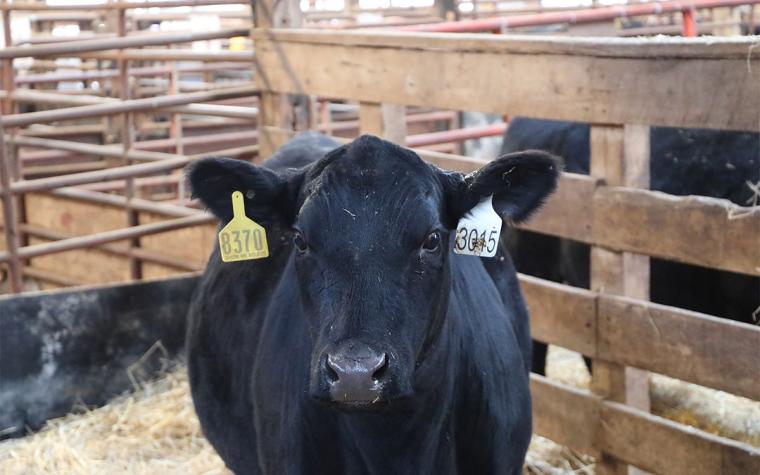COLUMBIA, Mo. – Improving fertility in cows involves leveraging genetic selection and advanced genomic tools to enhance reproductive performance.
But genetic potential is only half the battle. Environment is the other half, said University of Missouri Extension state beef genetics specialist Jamie Courter at the recent Missouri Livestock Symposium in Kirksville.
“Fertility is a lowly heritable trait and, therefore, a lot of environmental factors can negatively impact a female with otherwise high genetic merit,” Courter said.
An animal’s phenotype, or the traits seen, is a combination of their genotype (genetic merit) and the environment in which they are raised. Environmental factors can include both Mother Nature as well as management decisions on the farm, she said.
“We can take females with poor genetics for fertility and manage them in a way that increases their likelihood of becoming pregnant,” Courter said. “Similarly, we can take females with excellent genetics for fertility and decrease their likelihood of becoming pregnant through poor management. When it comes to building better female cows, the goal should be to match their genetics to the environment.”
Because fertility is a lowly heritable trait, it is often more beneficial to focus on traits with higher heritability. When producers ask for increased fertility, they want more cows bred per year and therefore more calves weaned. There are many other traits with higher heritability that can result in the same outcome, she said. To match genetics to the environment, the first step is to define a breeding objective. The most important question to ask yourself when creating a breeding objective is “What is the biggest revenue generation on my operation?”
- Do you sell calves at weaning (is weaning weight important)?
- Do you retain ownership and market based on carcass quality?
- Do you sell Show-Me-Select heifers? There are expected progeny differences/traits that can be selected for in these situations, and many more.
Then follow that with questions such as:
- Are there other traits important to your operation?
- Do you work cattle with your kids or grandkids (is docility important)?
- What is the environment surrounding the cattle? Requirements for females in Missouri, with higher stocking rates and smaller pasture sizes, are different than for females in the Sandhills of Nebraska who need to travel much longer distances.
- What phenotypes are critically important to match these needs – e.g., feet and leg conformation, predator protection, etc.?
Expected progeny differences (EPDs) are a key tool in accurately implementing successful breeding programs. They predict the genetic potential of an animal as a parent and estimate the differences in performance traits that can be expected in that animal’s offspring.
Courter said EPDs should be seen as an additional tool to help producers make informed decisions that drive their breeding objectives and match cattle to their environment.
There are three nonnegotiables when genetically selecting a better cow herd:
1. Mature cow size. “While I often hear, ‘But my larger cows wean heavier calves,’ that isn’t the right question we should be asking,” Courter said. “Instead, we should ask ourselves, ‘Are larger cows as efficient as my lighter cows?’ To which the answer is a resounding ‘no.’” What resources did you concede to accommodate that larger cow? Cow size directly affects stocking rates. Decreasing mature cow size allows for increased stocking rates and therefore more calves weaned per year. In addition, larger mature-weight cows also take longer to reach puberty, decreasing their likelihood of conceiving in the first 21 days of the breeding season as a heifer.
2. Hair shedding. Earlier shedding cows tend to wean an older, heavier calf. (See the MU Extension publication “Hair Shedding Scores: A Tool To Select Heat Tolerant Cattle,” available for free download.) A female who does not shed her hair in a timely manner doesn’t match her environment. She is stressed in some way, be it due to nutrition, heat or health. Females who don’t shed their hair early are likely to have lower body condition at breeding due to heat stress during summer and are less likely to become pregnant.
3. Calving ease. Not a “more is more” type of trait. The goal of selecting for bulls with increased calving ease is to decrease dystocia (difficult or abnormal labor) events. However, stacking increased calving-ease bulls year over year can have detrimental effects on other traits of economic importance. “The genetic correlation between birth weight and weaning weight is 0.60, meaning that calves born smaller are typically smaller at weaning time,” she said. “This doesn’t bode well for profitability.” However, the genetic correlation between calving ease and weaning weight is only 0.32, meaning producers can select calving-ease bulls who have heavier calves at birth and therefore are heavier at weaning. From a producer’s perspective, calving ease is a threshold of “did I have to intervene or not?” In other words, calving ease is a trait to pay attention to when selecting bulls, especially for heifers. “However, if calving ease isn’t an issue in your herd, it may be worth discussing with myself or a trusted seedstock producer how to best manage those genetics moving forward,” Courter said.
At the end of the day, select bulls based on their genetic potential for traits of interest, she said. Use the information available to make educated decisions. Weigh the pros and cons of the bull. Normally, producers need multiple bulls – so balance out one bull’s deficit with another’s surplus. “But, before you get frustrated, realize it’s not easy. The perfect animal doesn’t exist, but we can make better decisions knowing that ahead of time instead of realizing we made the wrong decision 5-7 years down the road.”
Photo
Heifer
Heifer at Show-Me-Select sale in Kirksville, Mo. Photo by Sydney Winn, University of Missouri.
